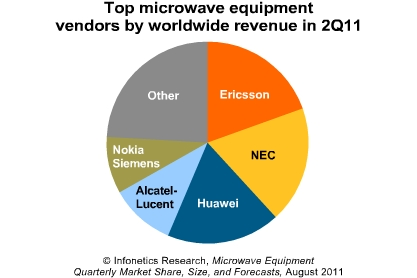2011年9月8日英国ロンドン発――市場調査会社Infonetics Research(インフォネティックス・リサーチ)社は、バックホール、トランスポート、およびアクセス系のネットワークで使用される大/低容量イーサネット、TDM、そしてハイブリッドといったマイクロ波装置の動向を追うベンダ市場シェアの調査・予測報告書『Microwave Equipment』第2四半期(2Q11)版の抜粋版を発表した。今回の報告書ではマイクロ波装置の分析・予測が1ギガヘルツ (GHz) から59.9GHzまでスペクトル周波数帯域ごとに収録されている。
アナリストノート
「過去一年半のあいだ、Huawei社は四半期ごとに90%以上の高成長率で収入を塗り替えてきており、2011年第2四半期を迎えた今では多年にわたり市場をリードしてきたEricsson 社やNEC社との市場シェア差が1ポイント未満にまで肉薄しています。近年の急激な収入増により、Huawei社は世界のマイクロ波市場第3位の地位を不動のものとしています。同社の成功に大きく貢献しているのは、23GHz、38GHzを初めとする高次スペクトルのマイクロ波装置分野における自社製品で、モバイルRANや光装置の顧客との契約を有効活用して好調な売れ行きを示しています。」とInfonetics Research社でマイクロ波分野を担当するRichard Webb (リチャード・ウェブ) 氏は見る。

マイクロ波装置市場のハイライト
- マイクロ波装置市場全体が2011年第2四半期は世界総計13億ドルと前四半期比2.4%の小幅上昇を示しているが、これはマイクロ波市場大半を覆う価格崩壊がイーサネットマイクロ波装置、イーサネット/TDMハイブリッドマイクロ波装置の収入増を食う形となったためである。
- キャリアは既に抱える3Gネットワークでのトラフィックを伸ばすことで4G/LTEサービスの開始に向けた準備を進めようとしているため、モバイル・バックホール帯域の拡張需要が今後もイーサネットマイクロ波装置市場を牽引する。
- 4ギガネットワークの周密なストリートセルトポロジーでの需要が見込まれているため、スモールセルのバックホール・ソリューションが既にマイクロ波装置市場に入り込みつつあり、屋外全域をカバーする低消費型「ゼロフットプリント」の動きが目立つ。
- マイクロ波装置ベンダは大容量製品を強調しており、1ギガを超える容量のリンクを唱えるベンダも数社出てきている。
- 2011年から2012年のあいだにイーサネット・マイクロ波ラジオ装置の世界出荷量は倍増すると見られるが、TDMマイクロ波装置は今後も衰退を避けられず、TDM/イーサネット・ハイブリッドマイクロ波装置は加速する模様。
- イーサネットマイクロ波装置の収入は2010年にTDMマイクロ波装置の収入を超えており、2014年までにTDM/イーサネット・ハイブリッドマイクロ波装置の収入をも超える見込みである。
- 北米でマイクロ波装置への消費が最も著しく成長する野は2011年から2015年となる見込みである。スペクトル帯域幅が4-7.99GHz、8-11.99GHz、12-17.99GHzの装置は2010年のマイクロ波装置収入の82%を占めている。
Ericsson, NEC, Huawei now within 1 market share point of each other in microwave market
London, UK, Sept. 8, 2011—Market research firm Infonetics Research today released excerpts from its second quarter (2Q11) Microwave Equipment vendor market share and forecast report, which tracks high- and low-capacity Ethernet, hybrid, and TDM microwave equipment used in backhaul, transport, and access networks. The report now includes analysis and forecasts of microwave equipment by spectrum frequency band, from 1 GigaHertz (GHz) to 59.9 GHz.
ANALYST NOTE
"Over the last 18 months, Huawei increased their quarterly microwave equipment revenue by over 90%, which now puts them within about a point of market share from perennial leaders Ericsson and NEC as of the second quarter of 2011. Huawei’s most recent revenue surge firmly establishes them as the #3 microwave equipment player in the world. Their success can largely be attributed to the considerable amount of higher-spectrum microwave gear they sell, particularly 23- and 38-GHz equipment, and to leveraging their contracts with their mobile RAN and optical equipment customers," observes Richard Webb, directing analyst for microwave at Infonetics Research.
MICROWAVE EQUIPMENT MARKET HIGHLIGHTS
- The overall microwave equipment market edged up 2.4% in 2Q11 over 1Q11, to $1.3 billion worldwide, as price erosion across most microwave market segments ate into revenue gains in Ethernet and hybrid TDM/Ethernet microwave gear
- As carriers seek to accommodate traffic growth on their 3G networks and prepare for 4G/LTE service launches, the need for enhanced mobile backhaul bandwidth will continue to drive the Ethernet microwave equipment market
- In preparation for the expected need for denser on-the-street cell topologies in 4G networks, small cell backhaul solutions are already coming to the microwave equipment market, sporting all-outdoor 'zero footprint' lower power form factors
- Microwave equipment vendors are emphasizing new higher-capacity products, with several vendors now claiming 1G+ capacity links
- Between 2011 and 2012, global shipments of Ethernet microwave radio equipment are forecast to double, while TDM microwave gear will continue its inexorable decline, and the decline of hybrid TDM/Ethernet microwave gear will accelerate
- Revenue from Ethernet microwave equipment surpassed that of TDM microwave in 2010, and is expected to overtake hybrid TDM/Ethernet microwave equipment by 2014
- The sharpest growth in microwave equipment spending will come from North America between 2011 and 2015
- Equipment in the spectrum clusters 4-7.99GHz, 8-11.99GHz, and 12-17.99GHz accounted for 82% of microwave equipment revenue in CY10

